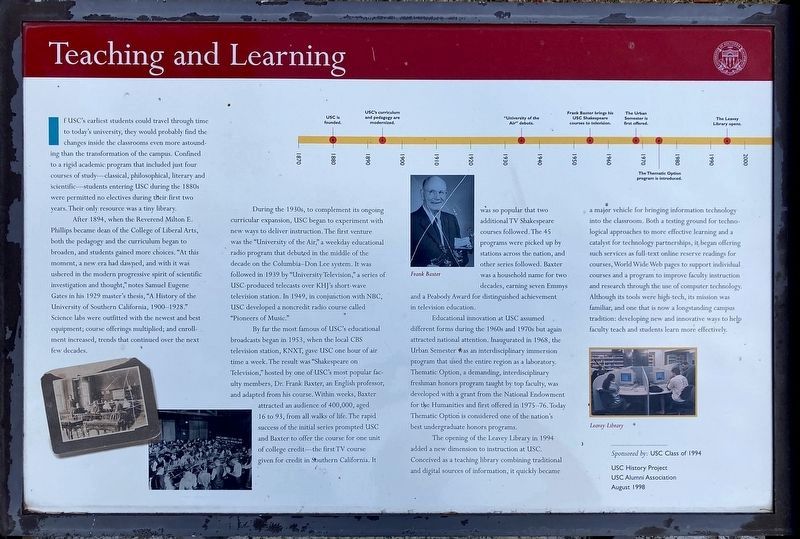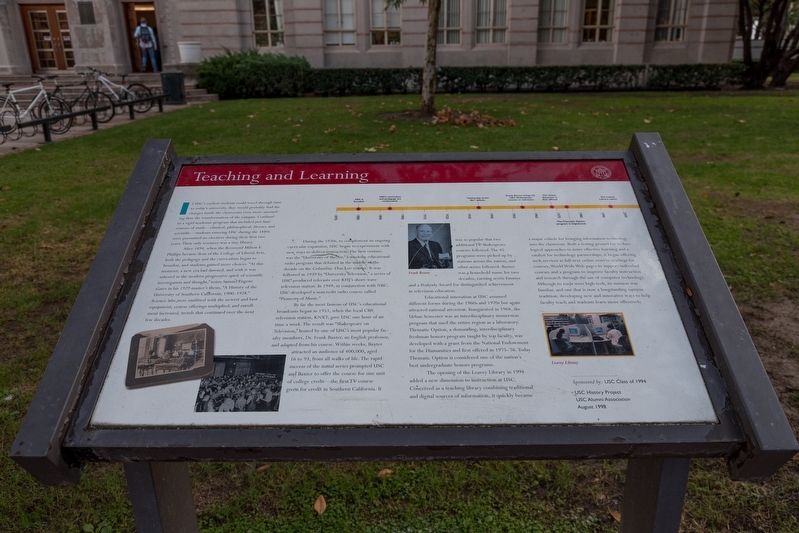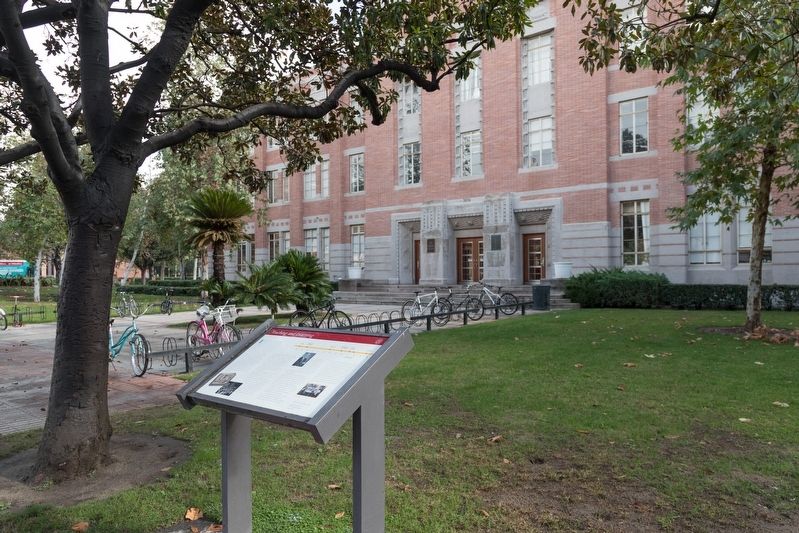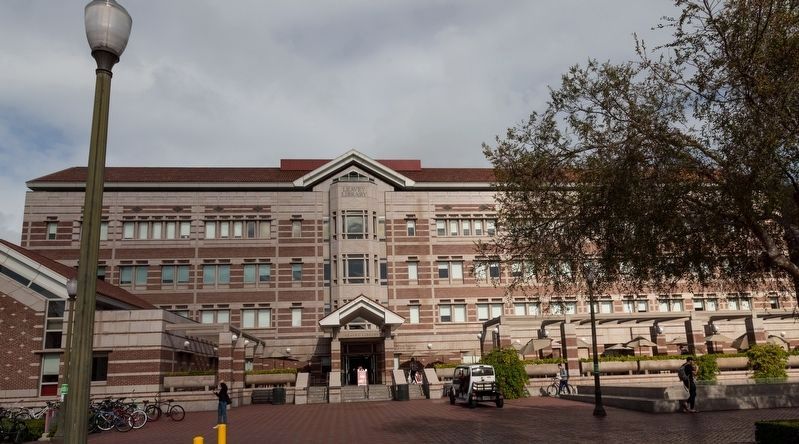South Los Angeles in Los Angeles County, California — The American West (Pacific Coastal)
Teaching and Learning
— USC — University of Southern California —
After 1894, when the Reverend Milton E. Phillips became dean of the College of Liberal Arts, both the pedagogy and the curriculum began to broaden, and students gained more choices. “At this moment, a new era had dawned, and with it was ushered in the modern progressive spirit of scientific investigation and thought,” notes Samuel Eugene Gates in his 1929 master’s thesis, “A History of the University of Southern California, 1900-1928.” Science labs were outfitted with the newest and best equipment; course offerings multiplied; and enrollment increased, trends that continued over the next few decades.
During the 1930s, to complement its ongoing curricular expansion, USC began to experiment with new ways to deliver instruction. The first venture was the “University of the Air,” a weekday educational radio program that debuted in the middle of the decade on the Columbia–Don Lee radio network. It was followed in 1939 by “University Television,” a series of USC-produced telecasts over KHJ’s short-wave television station. In 1949, in conjunction with NBC, USC developed a noncredit radio course called “Pioneers of Music.”
By far the most famous of USC’s educational broadcasts began in 1953, when the local CBS television station, KNXT, gave USC one hour of air time a week. The result was “Shakespeare on Television,” hosted by one of USC’s most popular faculty members, Dr. Frank Baxter, an English professor, and adapted from his course. Within weeks, Baxter attracted an audience of 400,000, aged 16 to 93, from all walks of life. The rapid success of the initial series prompted USC and Baxter to offer the course for one unit of college credit—the first TV course given for credit in Southern California. It was so popular that two additional TV Shakespeare courses followed. The 45 programs were picked up by stations across the nation, and other series followed. Baxter was a household name for two decades, earning seven Emmy and a Peabody Award for distinguished achievement in television education.
Educational innovation at USC assumed different forms during the 1960s and 1970s hut again attracted national attention. Inaugurated in 1968, the Urban Semester was an interdisciplinary immersion program that used the entire region as a laboratory. Thematic Option, a demanding, interdisciplinary freshman honors program taught by top faculty, was developed with a grant from the National Endowment for the Humanities and first offered in 1975-76. Today Thematic Option is considered one of the nation’s best undergraduate honors programs.
The opening of the Leavey Library in 1994 added a new dimension to instruction at USC. Conceived as a teaching library combining traditional and digital sources of information, it quickly became a major vehicle for bringing information technology into the classroom. Both a testing ground for technological approaches to more effective learning and a catalyst for technology partnerships, it began offering such services as full-text online reserve readings for courses, World Wide Web pages to support individual courses and a program to improve faculty instruction and research through the use of computer technology. Although its tools were high-tech, its mission was familiar, and one that is now a longstanding campus tradition: developing new and innovative ways to help faculty teach and students learn more effectively.
Erected 1998 by USC History Project, USC Alumni Association. Sponsored by USC Class of 1994.
Topics. This historical marker is listed in these topic lists: Communications • Education. A significant historical year for this entry is 1894.
Location. 34° 1.183′ N, 118° 17.131′ W. Marker is in Los Angeles, California, in Los Angeles County. It is in South Los Angeles. Marker is on Trousdale Parkway south of Childs Way, on the left when traveling south. It is in front of the Hancock Foundation Building. Touch for map. Marker is in this post office area: Los Angeles CA 90089, United States of America. Touch for directions.
Other nearby markers. At least 8 other markers are within walking distance of this marker. Hancock Foundation Building (a few steps from this marker); Gwynn Wilson Student Union (within shouting distance of this marker); Student Media (within shouting distance of this marker); A Gathering Place (about 300 feet away, measured in a direct line); Endowing the Future (about 300 feet away); Town and Gown of USC (about 400 feet away); Doheny Memorial Library (about 400 feet away); Mudd Memorial Hall (about 500 feet away). Touch for a list and map of all markers in Los Angeles.
More about this marker. This marker has a timeline from 1870 to 2000 marking when USC was founded, USC’s curriculum and pedagogy are modernized, “University of the Air” debuts, Frank Baxter brings his USC Shakespeare courses to television, the Urban Semester is first offered, the Thematic Option program is introduced, and the Leavey Library opens. It has a number of illustrations (clockwise from center): “Frank Baxter,” “Leavey Library,” and photographs of a 19th century classroom and a laboratory.
Also see . . . Don Lee Radio Network. Excerpt: “In 1929, Don Lee Network and CBS entered into an agreement that created the Don Lee-Columbia Network, making the Lee stations the West Coast affiliates for CBS. The joint operation was launched on January 1, 1930. A typical schedule had the network carrying CBS programs in the early evening. When those ended at 8 p.m. Pacific Time, either KFRC or KHJ provided network programs, with the two usually alternating evenings. Some of the programs originating at one of the Lee stations were also transmitted nationally by CBS.” (Submitted on January 10, 2019.)
Credits. This page was last revised on July 29, 2023. It was originally submitted on January 10, 2019, by J. J. Prats of Powell, Ohio. This page has been viewed 215 times since then and 10 times this year. Photos: 1. submitted on July 29, 2023, by Craig Baker of Sylmar, California. 2, 3, 4. submitted on January 10, 2019, by J. J. Prats of Powell, Ohio.



